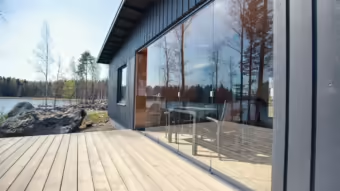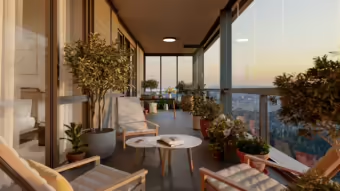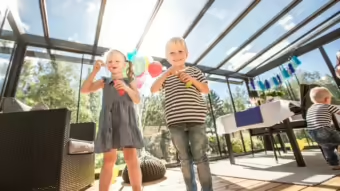
Can You Barbecue in Your Sunroom?
For many people, barbecuing is synonymous with summertime. But summertime isn’t always synonymous with sunshine, and you could encounter torrential downpour when you plan on having your next cookout.
If the weather isn’t cooperating, you might think about moving your barbeque to your sunroom and use it to the fullest of its potential. While the idea of grilling in a sunroom may sound appealing, several important factors need to be considered before firing up the grill indoors. From safety concerns to ventilation and space limitations, grilling in a sunroom isn’t as straightforward as it might seem.
Before you migrate inside, here’s everything you need to know about safely barbecuing in your sunroom. In this article, we’ll explore the feasibility of barbecuing in a sunroom and the steps you can take to make it safe and enjoyable.
Fire Safety 101
In the United States, there are many comprehensive resources for homeowners to learn more about fire safety codes that apply to them.
Both codes emphasize that charcoal grills and gas grills should only be used in well-ventilated outdoor areas. These pose greater fire risks when used in enclosed spaces—like sunrooms—due to their open flame and the high temperature they generate. As well, gas grills can leak propane or natural gas, which could cause an explosion if you don’t properly maintain the grill or use it in an unventilated space.
Where you live can also have quite an impact on your plans to grill in your sunroom. Some states and municipalities may have their own specific rules or fire bans that apply to grilling. As well, your homeowner’s association may have specific rules when it comes to grilling.
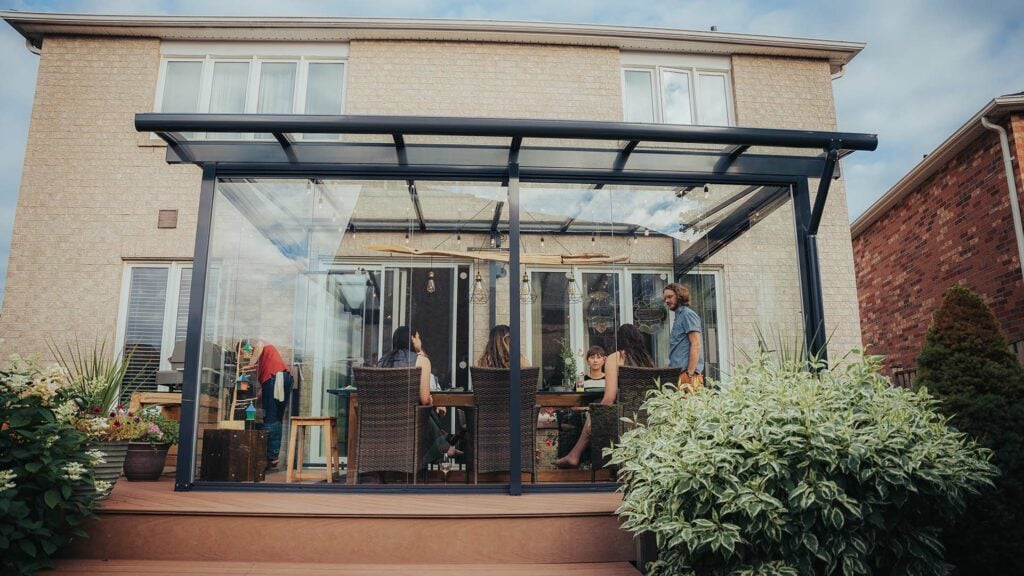
Structural Considerations For Safer Grilling
A sunroom is a space designed to bring the outdoors inside, typically with large windows or glass panels that offer abundant natural light. But not all sunrooms are created equally. The materials used, the layout of the room, and the type of heating or cooling system can vary widely.
Fire-resistant materials
Many sunrooms aren’t built with the fire-resistant materials or the extended safety features to handle grilling. The heat from the grill could potentially damage your sunroom’s structure, especially if it’s made from flammable materials. Lumon’s sunrooms are built with glass and aluminum, which are more resistant to heat than acrylic and wood, but aren’t impervious to fire damage.
Layout & design
Homeowners use their sunrooms for all sorts of reasons, and that lends to differences in their sunroom’s design. Some sunrooms have an open, accessible layout, while others are more enclosed and insulated. Make sure you have enough room to safely operate the grill and cook food. You should never place the grill too close to walls, furniture, or any combustible materials.
Your layout is important to consider because if the worst possible scenario happens, you need to be prepared to get yourself and your loved ones out of your sunroom quickly. Any obstacles in the way could drastically change the outcome.
Ventilation
Without proper ventilation, toxic gases like carbon monoxide (CO) can build up quickly in a sunroom—especially if the grill is not designed for indoor use. Luckily, there are easy ways to vent more air in and out of your sunroom. One way is to install a range hood or industrial exhaust fan to promote airflow, but this can be noisy and distracting.
If you plan on barbecuing in your sunroom, the type of retractable glass walls you invest in matters a lot. Unlike others on the market, Lumon’s retractable glass systems can fully open and allow fresh air to flow in, and smoke to escape. With only 1.5″ stacking on each panel, this means they can open to 95% of their range, unlike the other options that often don’t even reach 50%.
Fire extinguishers
Most fire safety regulations in America require homeowners to have a working fire extinguisher in areas where grilling or cooking is taking place, including sunrooms.
Even without it being a requirement, keeping a fire extinguisher nearby wherever you’re cooking is a great practice to be sure you have it handy if you ever need it; no one wants to be scrambling in an emergency.
Clean-up
Barbecuing creates grease, smoke, and odors, which can linger if you don’t maintain a cleaning routine. Even if you clean all the visible grease and soot, the furniture in your sunroom can absorb the smell of smoke and the food you’ve grilled. Clean your sunroom thoroughly after each use to avoid the buildup of grease or lingering smells.
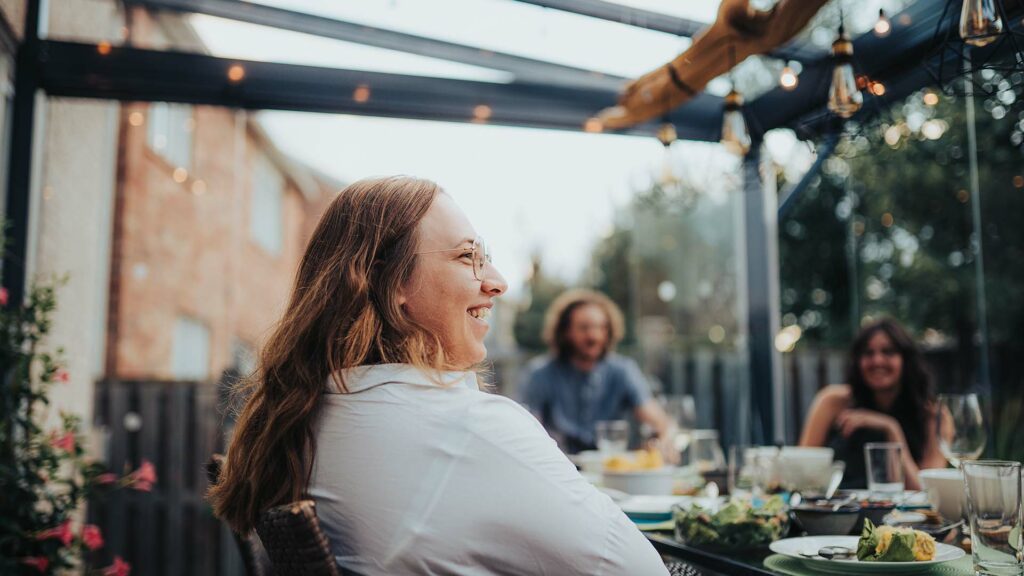
Safer Alternatives to Grilling
The wider consensus on grilling in a sunroom is only do it with several precautions and plans in place. If you’re determined to grill in your sunroom, we recommend exploring alternative grilling equipment designed for indoor use instead.
These types of grills are generally safer and more suited to the confined spaces of a sunroom. However, you should research its suitability for your space, as some condo buildings don’t allow use of these options.
- Electric grills are a popular choice for indoor grilling because they don’t produce an open flame. These grills are relatively compact, making them ideal for small spaces like sunrooms. They use electricity to heat the grilling surface, eliminating the need for charcoal or gas. While they may not replicate the exact flavor of a traditional BBQ grill, electric grills are much safer for indoor use.
- Infrared grills use a radiant heat source to cook food, offering a similar experience to traditional grilling but with less smoke and fewer fire hazards. Many infrared grills are compact and can be used indoors, though they still require good ventilation.
- Smokeless grills are designed to minimize smoke production. These grills often feature an advanced system that reduces smoke while still providing a satisfying grilling experience. Some models even come with built-in fans to ensure that smoke is directed away from the cooking surface.
We know these aren’t quite the same as grilling on a traditional charcoal or gas grill, they can still offer a tasty and safer way to entertain guests in your sunroom.
Takeaways About Barbecuing in Your Sunroom
While grilling in a sunroom can seem like an attractive idea, American regulations around fire safety, ventilation, and carbon monoxide prevention make it clear that traditional barbecuing in a sunroom is not advised on a regular basis.
If you need to take grilling indoors, the safest course of action is to avoid using gas or charcoal grills in enclosed spaces like sunrooms due to the fire risks and the potential dangers associated with poor ventilation.
Learn more from our blog
-
How Much Does a Sunroom Cost?
Read more…Sunrooms have become a popular addition for homeowners looking to enhance their living space and connect with the outdoors without compromising comfort. However, as delightful as they may be, planning your sunroom involves understanding the factors that influence its cost.
-
-
How to keep cool in a summer sunroom
Read more…Sunrooms can be great in-between spaces, where you get the best of both worlds. However, in the summer, even these spaces can get quite warm without preparation. One benefit is that the space acts as a buffer to your home, so the cooling needs for inside your home may actually be less.
